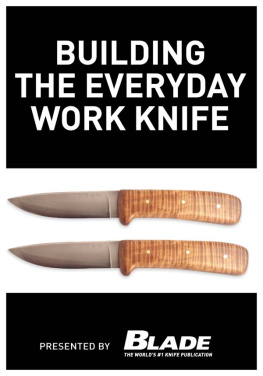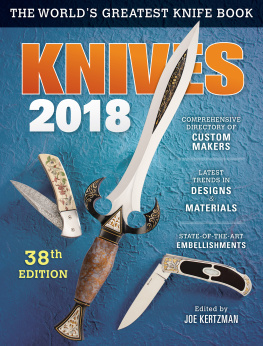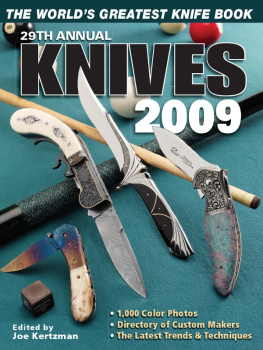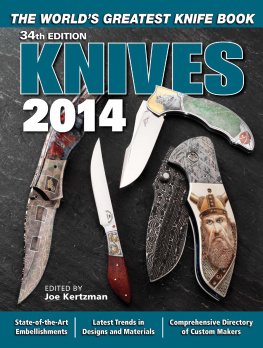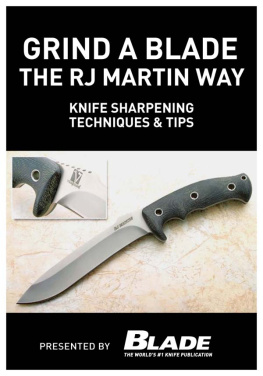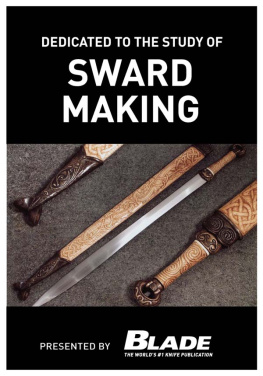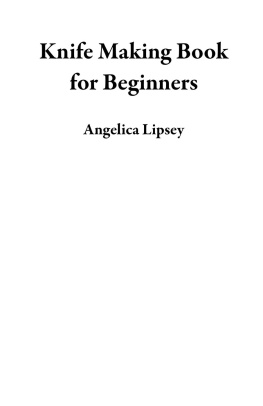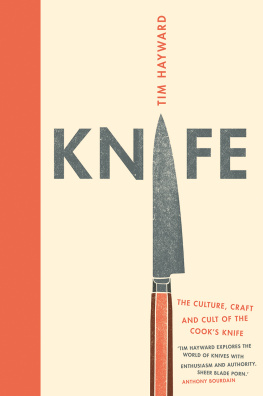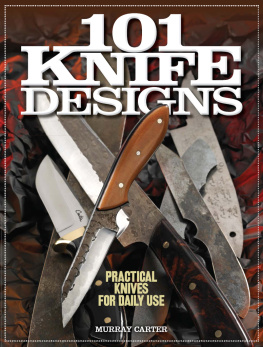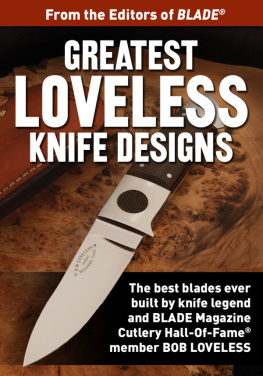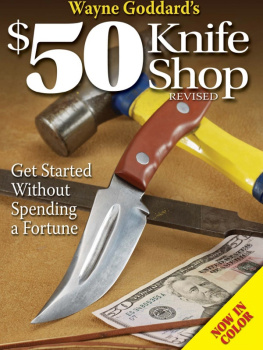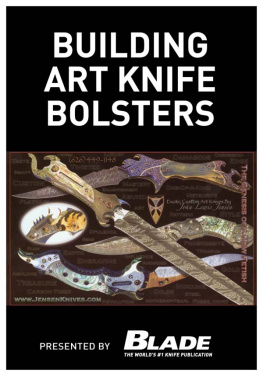Joe Kertzman - Building the Everyday Work Knife
Here you can read online Joe Kertzman - Building the Everyday Work Knife full text of the book (entire story) in english for free. Download pdf and epub, get meaning, cover and reviews about this ebook. year: 2012, publisher: F+W Media, genre: Home and family. Description of the work, (preface) as well as reviews are available. Best literature library LitArk.com created for fans of good reading and offers a wide selection of genres:
Romance novel
Science fiction
Adventure
Detective
Science
History
Home and family
Prose
Art
Politics
Computer
Non-fiction
Religion
Business
Children
Humor
Choose a favorite category and find really read worthwhile books. Enjoy immersion in the world of imagination, feel the emotions of the characters or learn something new for yourself, make an fascinating discovery.
- Book:Building the Everyday Work Knife
- Author:
- Publisher:F+W Media
- Genre:
- Year:2012
- Rating:3 / 5
- Favourites:Add to favourites
- Your mark:
- 60
- 1
- 2
- 3
- 4
- 5
Building the Everyday Work Knife: summary, description and annotation
We offer to read an annotation, description, summary or preface (depends on what the author of the book "Building the Everyday Work Knife" wrote himself). If you haven't found the necessary information about the book — write in the comments, we will try to find it.
Author of such books as Wayne Goddards $50 Knife Shop and The Wonder of Knifemaking, Wayne Goddard takes you through his proven process of making the everyday working knife. Goddard speaks the language of ordinary people who like to use knives theyve made themselves.
Building the Everyday Work Knife — read online for free the complete book (whole text) full work
Below is the text of the book, divided by pages. System saving the place of the last page read, allows you to conveniently read the book "Building the Everyday Work Knife" online for free, without having to search again every time where you left off. Put a bookmark, and you can go to the page where you finished reading at any time.
Font size:
Interval:
Bookmark:


Heres the author at work in his backyard as it was setup for The $50 Knife Shop project. Originally a series of articles in BLADE Magazine, a book compilation, titled Wayne Goddards $50 Knife Shop, is available from the publisher of this book.
My experience has taught me that theres nothing like digging in and getting started. Ive often said the hardest part of the most difficult project I ever completed was getting past the decision to get started. Once I get started, it becomes a matter of problem solving and never giving up. The great inventor Thomas Edison wrote, Many of lifes failures are people who did not realize how close they were to success when they gave up.
I have some strong opinions about how a new knifemaker should get started. I recommend the first knives be made with simple and even makeshift tools. Thats the kind of thing that lets you ease into knifemaking without spending a lot of money. See the photo of a backyard knife shop. If the simple method is not for you, it wont hurt my feelingsjust grab your checkbook and credit cards and head for town. Dont forget the list of basic tools.
Im what you would call an old-school knifemaker. Thats because I never learned CAD (Computer Aided Design) or CAM (Computer Aided Manufacturing). I dont work with titanium or drill and tap a lot of holes in order to put knives together with screws. To me, old school is riveting together the handle and blade tang, giving the knife a unique personality by hand finishing all the parts. There are no square cornerseverything is rounded, smooth and friendly.

This is the first knife the author ever made, and his only excuse is that he didnt know any better. He says to put this one in the ugly file.

Computer magic shows the project knife with two different handle lengths.
Its been said that good designs evolve, and I believe it. When I got started in knifemaking, I didnt have one clear thought about design. I grabbed the only suitable knifemaking material I could find and went to work grinding on it. There was no thought as to knife proportions or design principles. I had built myself a grinder, and the thrill of shaping steel drove my activity.
The result was a blade that wasnt practical and a handle that was too short. See the related illustration. The knife models Ive developed to date are good designs because they evolved. It just isnt possible to get everything right the first time. A maker starting out today has some advantages. He or she typically has access to books and magazines full of good knife designs to study and analyze. Today, there isnt much of an excuse for making ugly knives.
Perhaps the best thing I can teach about design is to consider the flow of the lines that define a knifes shape. Dont do things that disrupt the flowing lines of the knife. The new knifemaker should try different styles, shapes and sizes when starting out in this field. With experience he or she will find a unique style.
Years ago, I settled on a length of 3 78 inches as the ideal size for a hunting knife blade. A blade that stretched 4 inches seemed a bit too long, but a similarly shaped blade at 3 34 inches was too short. Splitting the difference gave me a blade length of 3 78 inches and I was comfortable with that size.
When you become accustomed to using a knife with a 4-inch blade and then switch to one thats slightly shorter, or longer, youll notice a difference, and you might not feel comfortable. Ive offered a basic hunting knife blade of 3 78 inches to my customers as a standard size ever since deciding on it and they seem to be comfortable with that length.
An ideal handle length can be difficult to determine, mainly because peoples hands all come in different sizes. Ive got short arms and small hands for my height, and at first, I made knife handles that were too short for some folks. I finally learned to make the handles longer to accommodate the general public. On occasion, I might even go oversize on handle length in an attempt to keep the grip from being too short.
I outfitted the project knife for this book with my standard 4 14-inch handle. A knife handle of this size can be used on blades that are up to a half-inch longer than the project blade. See the accompanying photo for two versions of the knife. The knife on the right in the photo is the full-sized project knife, and on the left is a computer-enhanced version with a slightly shorter handle. Use your judgment on handle length but dont opt for a grip shorter than 4 inches.
Over the years Ive received many beautiful drawings of proposals for both fixed-blade and folding knives. Many of the fixed-blade drawings were not practical to make because the handles, as drawn, were too short.
Knives on paper look quite a bit different than they do when mocked up in wood or cardboard. The folding knife drawings were often attractive in appearance but had blades that would not fit into the handles when folded. For these reasons, its always good to make mock-ups of new designs. This gives you non-working models to hold in your hands, and thats just one more step towards real knives of good designs.
Paper drawings dont work out too good for me because I cant draw a straight line or an evenly curved one. What I can do is use the belt grinder to grind straight and curved lines that are what they should be.
A drawing can be scanned into a computer and then printed out to whatever size is wanted. Once the design on paper is finalized and printed out, I use rubber cement to glue the printout to a piece of thin hardboard or plywood. The pattern is then sawed, sanded or whittled to shape. The physical pattern gives me something to hold in my hand and some idea as to proportion and size. This is where needed changes become more obvious and can be made. If the pattern isnt right, Ill use whatever parts of it are right to make another pattern that will get me closer.
Once the hard pattern is satisfactory, it is transferred to steel and the real work starts. I keep a lot of the hard patterns I make. Having a collection of rough models on hand gives me a head start on size proportions when I have a new design to develop. Storage of the physical patterns has become a problem, so for the last several years Ive kept many of them as tracings in a big book.
Ive found it useful to have a collection of handles. My customers furnished some of them, while others came off of knives I customized, and at least three came from broken knives. There are lessons in all of them, both good and bad. Often, a new design comes together quicker because I have an actual handle to work from. See the photo of Waynes handle collection.

Waynes handle collection hangs around under a high shelf until one in the collection is needed.
Font size:
Interval:
Bookmark:
Similar books «Building the Everyday Work Knife»
Look at similar books to Building the Everyday Work Knife. We have selected literature similar in name and meaning in the hope of providing readers with more options to find new, interesting, not yet read works.
Discussion, reviews of the book Building the Everyday Work Knife and just readers' own opinions. Leave your comments, write what you think about the work, its meaning or the main characters. Specify what exactly you liked and what you didn't like, and why you think so.

